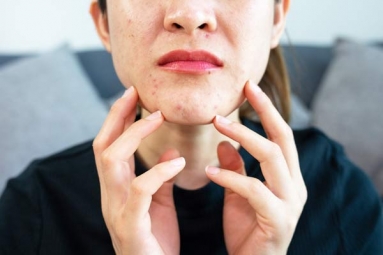
(Image source from: Freepik.com)
Embracing one's natural body and facial hair is laudable, but many opt to remove it for comfort or aesthetic enhancement. Selecting the right hair removal method is crucial, as each approach has its own advantages and drawbacks. While waxing can be painful, shaving leads to rapid regrowth, and laser hair removal is a consideration for many. To provide a comprehensive guide, experts offer insights on various hair removal options:
Waxing: This popular method involves applying a sticky substance to the skin, which adheres to the hair. When the wax is removed, it pulls the hair out from the root, resulting in more prolonged smoothness, as explained by Dr Rishabh Raj Sharma, a dermatologist at Noida International Institute of Medical Sciences (NIIMS). There are two types of wax used: soft wax, also known as strip wax, which is removed with a cloth or paper strip, and hard wax, which hardens on the skin and is removed without strips. Waxing offers an immediate solution, and many find it convenient, as the regrowth takes time after the hair is pulled out.
Waxing can temporarily remove hair, but it also carries some potential downsides. The pulling motion can strip away some dead skin cells, creating a slight skin-smoothing effect. However, frequent waxing can weaken hair follicles over time, resulting in thinner and less dense hair growth. For those with sensitive skin or who are new to waxing, the process can be quite painful. After waxing, the skin may become irritated, with redness, bumps, and even ingrown hairs. Professional waxing services can be costly, and at-home kits may not always provide the same quality results. Some individuals may even experience allergic reactions to the wax or its ingredients, leading to further skin issues. Waxing also involves the removal of live hair roots, which can cause infection or inflammation around the hair follicles, manifesting as red bumps.
Shaving, on the other hand, is a common and straightforward hair removal method. It involves using a razor to cut the hair at the skin's surface. This process can act as a form of physical exfoliation, smoothing the skin by removing dead cells. However, shaving can also lead to irritation, especially for those with sensitive skin or if the technique is not executed properly.
Shaving at home is a straightforward task that doesn't necessitate the involvement of experts or specialised tools. When executed properly, the process typically causes little discomfort, making it a convenient choice for a wide range of people.
Shaving only removes superficial hairs, which grow quickly and require frequent, often daily, grooming. The process can also cause skin irritation such as razor bumps, redness, and bumps, especially if a dull blade is used or excessive pressure is applied. Shaving can cause ingrown hairs, especially if you have curly or curly hair, and there is always the risk of cuts and cuts, especially in sensitive areas.
Laser hair removal: This process targets hair follicles with a focused beam of light, effectively damaging them and preventing future hair growth. During the procedure, a dermatologist or trained technician uses a laser device that emits light that is absorbed by the hair pigment (melanin). This light energy is converted into heat and damages the hair follicle without harming the surrounding skin. Experts believe that laser hair removal is more effective on people with dark hair and light skin because the contrast allows the hair to be targeted more precisely without affecting the skin. Laser hair removal can significantly reduce hair growth. However, not everyone can get rid of unwanted hair permanently and it needs to be cared for over time. This method is great for people with growth problems or allergies. Its precision allows the laser to target dark, coarse hair without damaging the surrounding skin, making it effective on small, specific areas such as the upper lip, chin and bikini line.
Laser hair removal typically requires multiple sessions (usually 6 to 8) spaced a few weeks apart to achieve the desired results, and this process is time-consuming and expensive. This procedure can be expensive, especially if multiple sessions are required. Temporary side effects such as redness, swelling and mild discomfort are common, but in rare cases more serious problems such as blistering, scarring and changes in skin pigmentation may occur.
Removal of unwanted hair: Like waxing, various hair removal methods are used such as: B. an epilator, plucking and threading the hair at the root. Although the effects of hair removal last longer compared to shaving, hair removal can be uncomfortable, especially in the first session and for people with sensitive skin. One of the main benefits is that hair is removed from the root, resulting in smooth, hair-free skin for weeks. An electric hair removal device allows you to remove unwanted hair at home, which is convenient and eliminates the need for frequent visits to the salon. It acts on different areas of the body and can remove hair as short as 0.5mm, unlike waxing which requires long hair to effectively remove hair.
For some people, hair removal can be uncomfortable. Some people may also experience redness, burning, and ingrown hairs. Due to the mechanical nature of hair removal, there is a risk of hair breakage and stubble instead of complete hair removal.
Depilatory creams and powders: Depilatory creams and powders dissolve hair. They contain enzymes that help dissolve hair strands. So, unlike shaving, when you cut your hair, you weaken the hair shaft. The result will be a creamy mass, which must then be scraped off. Similar to shaving, this process removes hair from the surface of the skin, not the root. These products contain active ingredients such as calcium thioglycolate or potassium thioglycolate, which penetrate the hair follicles and break down the keratin bonds of the hair shaft. This process is quick and painless. This is easy to do at home and results in smoother skin than shaving. The chemicals in hair removal creams and powders can cause skin irritation or allergic reactions. The results don't last long. The strong smell of cream or powder can be intimidating.
Which one is better?
Before trying a new method, such as a hair removal cream, do a patch test to see if you experience any side effects. Whether waxing, shaving or creaming, follow the instructions carefully for optimal results. Regular exfoliation can help prevent hair loss. Don't forget to hydrate your body before using a depilatory cream or razor. For optimal results, consult a professional before laser hair removal or waxing.






